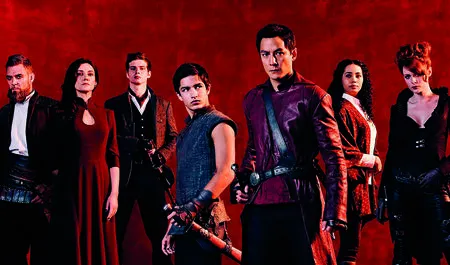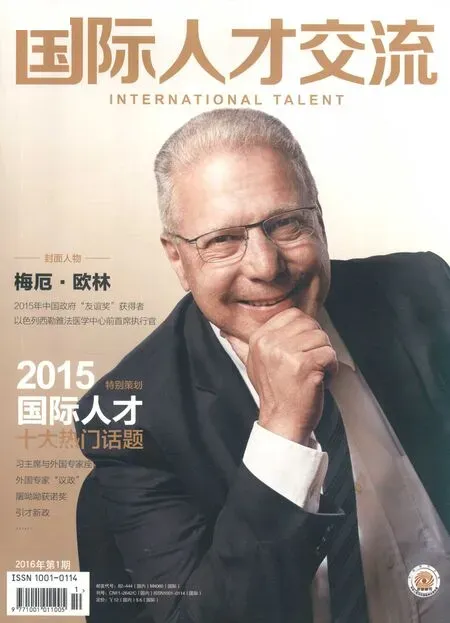美劇里的“中國(guó)風(fēng)”Asian Stardom
文、譯/孫曄
美劇里的“中國(guó)風(fēng)”Asian Stardom
文、譯/孫曄

中國(guó)影星吳彥祖在美劇《荒原》中擔(dān)任主演兼執(zhí)行制片人
從許多方面看,AMC電視臺(tái)新劇《荒原》借用了不少美劇的經(jīng)典套路。情節(jié)設(shè)定為末日后的一個(gè)荒涼世界,男主角曾劣跡斑斑,現(xiàn)在卻尋求新生。當(dāng)然,它還是一部激烈的動(dòng)作戲。
但從某種程度上說(shuō),《荒原》打破了好萊塢模式,啟用亞裔演員擔(dān)當(dāng)主角。
41歲的主演兼執(zhí)行制片人吳彥祖告訴《紐約時(shí)報(bào)》:“這確實(shí)很瘋狂。我從沒(méi)見(jiàn)過(guò)任何美國(guó)電視劇以亞洲人為招牌。”
《荒原》的故事發(fā)生在幾個(gè)世紀(jì)之后,一個(gè)叫荒原的封建社會(huì)誕生了。吳彥祖扮演的桑尼是這里最出色的殺手。他救出了一個(gè)叫M.K.(阿拉米斯·奈特飾)的男孩,這讓他想起了曾經(jīng)的自己。于是,混亂世界里的兩人一同踏上了尋找極樂(lè)世界的旅程。
以前,吳彥祖的這個(gè)角色可能就給了白人演員。但在本劇中,白人演員主要擔(dān)任配角,這些角色通常由“少數(shù)族裔”扮演。
In many ways, AMC’s latest drama Into the Badlands borrows some of American TV’s greatest clichés. It’s set against a bleak, post-apocalyptic setting, and its main character is a bad guy searching for redemption. And of course, it features high-octane action sequences.
But in one respect, Into the Badlands breaks the Hollywood mold. It casts an Asian-American as its romantic lead.
“This is crazy – I can’t remember seeing a billboard of an Asian dude on an American show, like, ever.” Daniel Wu, the show’s 41-year-old lead actor and executive producer, told The New York Times.
Into the Badlands envisions a world centuries from now. A feudal society known as The Badlands emerges, and Sunny, played by Wu, is the most lethal assassin in the land. When he rescues a teenage boy named M.K. (Aramis Knight), Sunny is reminded of the man he once was. M.K. and Sunny go together on a journey in search of enlightenment in their chaotic world.
In the past, Wu’s role might have gone to a Caucasian actor. But in this series, white actors play mostly supporting characters, roles

《荒原》劇照
美劇中不常見(jiàn)的中國(guó)武術(shù)也是《荒原》的一大特色。這是40多年來(lái)屈指可數(shù)的功夫劇。上一部以探索功夫?yàn)橹骶€的美劇,還是20世紀(jì)70年代的《功夫》,美國(guó)演員戴維·卡拉丹在劇中扮演一位少林和尚。
《紐約時(shí)報(bào)》報(bào)道說(shuō):“傳奇武打明星李小龍的傳記作者表示,李小龍之所以沒(méi)能出演那部劇(《功夫》)是因?yàn)殡娨暸_(tái)認(rèn)為美國(guó)觀眾不會(huì)對(duì)華裔武術(shù)家出演的電視劇感興趣,即便這部劇本身講的就是華裔武術(shù)家的故事。”
吳彥祖告訴電影、電視劇新聞網(wǎng)Collider:“演這部戲簡(jiǎn)直棒極了,特別是了解到有關(guān)《功夫》這部劇的選角歷史……更正錯(cuò)誤的事兒感覺(jué)很好。”
在武打戲中,《荒原》向著名功夫明星李小龍的電影《精武門》致敬,它還采用了香港武打片拍攝的技法。
《紐約時(shí)報(bào)》說(shuō):“在好萊塢動(dòng)作片中,導(dǎo)演用攝像機(jī)移位和特寫鏡頭掩飾演員拙劣的武術(shù)技巧。但在《荒原》中,導(dǎo)演采用長(zhǎng)鏡頭拍攝,觀眾能在一個(gè)鏡頭里看到10個(gè)人(甚至20、30人)打斗。”
吳彥祖在香港影壇摸爬滾打了18年,他對(duì)這種拍攝方式早已駕輕就熟。
“吳彥祖魅力非凡,身手敏捷。他為桑尼注入了豐富的情感和審慎的能量。“《綜藝》雜志評(píng)價(jià)道。
usually relegated to the “token minority”.
Badlands also features Chinese martial arts, a rarity on American TV. It is one of the few series in four decades to do so. The last major show to explore Chinese martial arts was the 1970s series Kung Fu, starring American actor David Carradine as a Shaolin monk.
“Biographers of the martial arts legend Bruce Lee claim that he lost out on the lead role in that earlier series because network execs didn’t think American audiences would watch a TV show starring a Chinese-American martial artist, even a show ostensibly about a Chinese-American martial artist.” The New York Times reported.
“It was a great feeling to be able to do this show, knowing the history of Kung Fu... It felt really great to be able to right that wrong.” Wu said to Collider, a movie and TV news website.
In its martial arts scenes, Badlands pays tribute to well-known Hong Kong action movies such as Bruce Lee’s Fist of Fury. Its fighting skills are also shot in a Hong Kong way.
“In Hollywood action movies, directors mask their actors’subpar fighting skills with shaky camera moves and extreme close-ups. In Badlands, the camera pulls way back, so that viewers can see 10 combatants (or 20, or 30) in a single shot.”said The New York Times.
Wu, having starred in Hong Kong films for 18 years, is a veteran of this style.
“Wu has the charisma and the action chops... Wu brings soulful presence and watchful energy to Sunny.” Variety commented.

